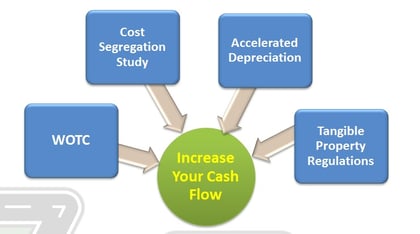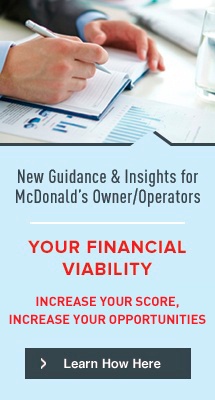 Sufficient cash flow is incredibly important as a McDonald’s Owner/Operator. It not only provides for smooth daily operations, but your cash flow coverage ratio is closely evaluated by corporate.
Sufficient cash flow is incredibly important as a McDonald’s Owner/Operator. It not only provides for smooth daily operations, but your cash flow coverage ratio is closely evaluated by corporate.
A great way to increase your cash flow is to reduce your taxes. Many tax benefits available to McDonald’s Owner/Operators were either re-instated or enhanced with the most recent tax legislation, so now is a great time to put them into effect for your business.
Check out these four tax benefits McDonald’s Owner/Operators should explore for increased cash flow:
Work Opportunity Tax Credit: The Work Opportunity Tax Credit – or WOTC – is a federal tax credit available to employers for hiring individuals from certain target groups who have consistently faced significant barriers to employment.
Target groups include qualified veterans, long-term or short-term TANF recipients, food stamp recipients, employees living in empowerment zones and ex-felons, among others. The maximum credits range from $2,400 for the general target groups all the way to $10,000 for certain qualified veterans and Welfare-to-Work employees.
When you hire qualifying employees at your restaurants, ask your new hires to fill out a form, and submit that form and any follow up documentation to your payroll/tax credit provider. Your payroll/tax credit provider will only charge you based on a percentage of the credits that you actually receive. So, there’s no risk.
READ MORE: McDonald's Owner/Operators Can Reap Benefits from Extended Work Opportunity Tax Credit
 Cost Segregation Study: If you recently built a new restaurant, rebuilt or relocated a restaurant or did an MRP, you should consider having a cost segregation study done on the building. These studies carve out the components of the building into different classifications, allowing you to depreciate some of the building components over a shorter life.
Cost Segregation Study: If you recently built a new restaurant, rebuilt or relocated a restaurant or did an MRP, you should consider having a cost segregation study done on the building. These studies carve out the components of the building into different classifications, allowing you to depreciate some of the building components over a shorter life.
Business property, as a whole, can be depreciated over 39 years. But many building components can qualify to be depreciated over far fewer years, which allows for greater tax savings.
A wide range of building elements can be classified as shorter-lived assets, including electrical installations, plumbing, mechanical components, and finishes. These assets can be depreciated over as little as 15, 7 or even 5 years. The shorter the asset’s useful life, the larger the current tax deduction, thus providing an incentive for tax purposes.
Cost segregation depreciation requires an engineering-based study, and while there’s a cost to such studies, there can be far greater tax savings.
Tangible Property Regulations: Congress issued final tangible property regulations back in 2014 which further defined what assets should be capitalized and which ones should be expensed. They even enhanced this for 2016 by allowing assets that would normally be capitalized to be expensed if the cost per item falls below $2,500.
For example, if you purchase three muffin toasters that cost $2,100 each, you can expense and deduct these toasters in the year of purchase, rather than capitalizing and depreciating them over time.
To use this tax benefit, you need to have a written accounting policy in place at the beginning of the year effectively adopting the $2,500 amount. Then these items can be directly expensed on your financial statements.
As before, businesses can still claim otherwise deductible repair and maintenance costs, even if they exceed the $2,500 threshold. For taxpayers with an applicable financial statement (i.e. audited financial statements), the de minimis or small-dollar threshold remains at $5,000.
READ MORE: IRS Increases Some Deductible Amounts for Small Business Purchases
Accelerated Depreciation: For larger equipment purchases, there are now two great depreciation options.
Section 179 Depreciation can be used to immediately write-off any equipment purchases up to $500,000. This tax benefit was made permanent as of late December.
Bonus Depreciation has been extended through 2019, though at decreasing amounts.
Through the end of 2017, Bonus Depreciation can be used to write-off 50 percent of the asset cost in the first year, and then you can depreciate the other 50 percent over the life of the asset. This benefit will be reduced to 40 percent in 2018 and to 30 percent in 2019.
Bonus Deprecation can only be used for new equipment purchases (Section 179 can be used for new or used equipment), but it can add up to big savings.
On their own or especially when all implemented in the same year, these four tax strategies can greatly improve the cash flow of a McDonald’s Owner/Operator. If you would like to get started on any of these initiatives, contact me at rcressman@concannonmiller.com or 888-433-1515.




